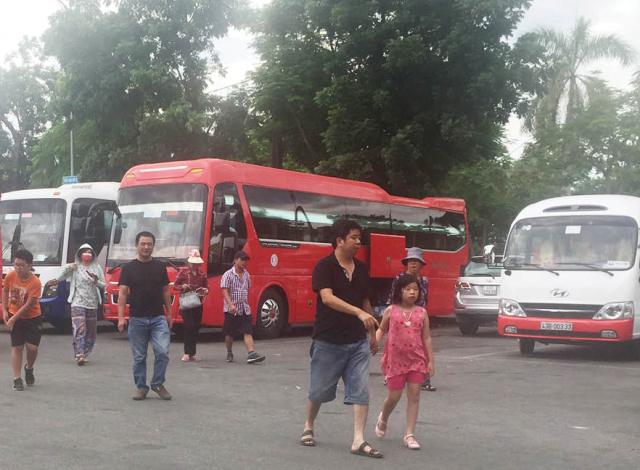Many overcrowded parking lots
The Nguyen Hoang tourist bus station offers a capacity of about 70 parking spots, 40 of which are for the large vehicles with 36 or more seats, the rest are for small and medium vehicles. On normal days, the bus station basically meets the demand; however, it is almost full at peak times, and many vehicles are not able to take a parking spot, so that some drivers have to unload passengers in the street or near the tourist sites.

Nguyen Hoang tourist bus station cannot meet the demand of parking at peak times
Recently, Hue City’s authority has proposed to the Province to facilitate drivers to take a parking spot in the front lawn of Nhac Hoa Vien when the Nguyen Hoang bus station is overloaded, in order that tourists could find it easier to visit the Imperial Citadel and other relics on the Northern side of Hue city. Simultaneously, they should accelerate the land clearance in Thuong Thanh – Eo Bau area to use a part of this ground for building a tourist car park. This solutionhelps reduce the load on the Nguyen Hoang bus station on peak days.
The parking lot in Doi Cung Street mainly serves tourist buses and taxis waiting for guests who are taking a Dragon boat ride or staying at some nearby hotels. However, along these routes, there are a large number of hotels and passengers, so this parking lot cannot meet the demand. Drivers struggle hard to find a proper space to park, especially for vehicles with 36 or more seats.
Some of the monuments and tourist attractions such as Thien Mu Pagoda, Nam Giao Esplanade, and some Royals Tomb lack parking lots. Although some places provideparking lots, they do not meet the general demand, or they havea small capacity and poor facilities, etc.
Flexibility in creating parking lots
In general, to create more parking lots to solve traffic problems, including tourist car parks, the provincial People’s Committee has many effective solutions such as approvingthe policy permitting enterprises to invest in the Multi-purpose Cultural Centre Project including the parking categorythat is expected to put into service in a few years.
In a short time, Hue City will coordinate with related agencies to use a part of the fund of land at the stadium on Nguyen Thai Hoc Street (Gate No.9) to serve as a parking lot for the so-called Western streets when these streets are exploited into a commercial travel and services area. Accordingly, vehicles will be banned from transporting in this area at night and on holidays to serve tourists who take sightseeing walks and go shopping.
The provincial People’s Committee has also approved the Investment in Parking Lot Project for tourists visiting Tu Duc Tomb and some nearby relics in Thuy Xuan Ward (Hue City). At the present, the investor has levelled the ground with a total area of nearly 17, 000m2. This ground together with accompanying auxiliary services will promisingly become a convenient stopping place for tourists.
The area in front ofthe Nam Giao Esplanade, at the intersection of Phan Boi Chau street, Dien Bien Phu street and Ngu Binh Street has been cleared up to make a green spot and park combined with a static traffic point for the Western part of Hue City.
For other locations, according to the Division of Urban Management of Hue City, they have advised the People’s Committee to lower the large sidewalks along some streets for parking spots, research to call for investments in parking lots in Phan Dang Luu street and Tran Hung Dao Street. In Dap Da area that leads to Vy Da,clearance and re-establishment are also proposed for better management and creating more parking spots.
In some streets in the central Southern part of Hue City such asTran Thuc Nhan street, Hai Ba Trung street and Nguyen Truong To Street, the sidewalks are proposed to be loweredwhile the Water Environment Improvement Project is implemented to create the static traffic point.
The provincial People’s Committee also assigns Hue City’s authority and related agencies to survey and propose the position and scale for a parking lot serving the Hon Chen Temple festival and other areas, for the purpose of developing tourism.
By Tam Hue
